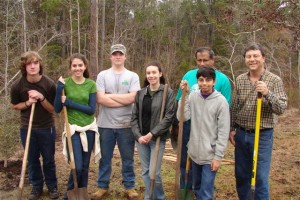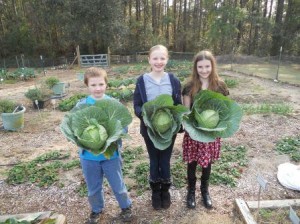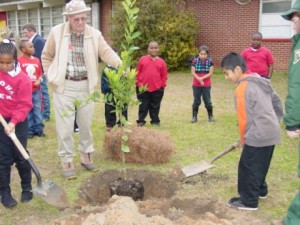by pmdavis | Nov 25, 2013
 Thanksgiving is a time of family traditions, reflection and thankfulness! Remember to include children in the planning and preparation. In 4-H, we stress learn by doing and want to encourage you to consider that motto. Children love being included that inspires their creativity, imagination and sense of belonging. Being involved teaches life skills, such as measuring, meal preparation, teamwork, design and relationship building.
Thanksgiving is a time of family traditions, reflection and thankfulness! Remember to include children in the planning and preparation. In 4-H, we stress learn by doing and want to encourage you to consider that motto. Children love being included that inspires their creativity, imagination and sense of belonging. Being involved teaches life skills, such as measuring, meal preparation, teamwork, design and relationship building.
Some ways to involve children are very simple! Have them help shop or find bargains with a Thanksgiving Scavenger Hunt. Give each child a list of grocery products to find. They will have fun locating items at the store or finding the best buys in advertisements. Older kids can clip coupons.
Make simple inexpensive decorations. Create turkey hand or leaf wall hangings, wreaths, a tree of thanks, clay or play dough holiday ornaments, centerpieces, placemats, name cards, napkin rings. Napkin rings can be made out of cut paper towel rolls or construction paper glued in a circle and decorated with artwork, fabric, leaves or even feathers. Guests will admire these items while enjoying the meal.
To help the day go smoothly, consider your needs and home size. For example, if you have a small kitchen let them help you prepare items ahead of time for the meal i.e cranberry salad. Consider having older youth select a recipe to be the lead chef. Doing a trial run prior to the holiday meal. Kids can easily help: wash fruits and vegetables, snap green beans, crack eggs, stir cake batter, roll out pie crusts, mash potatoes, sprinkling marshmallows or put relish items on a tray.
Let kids set the table. Make the task simple by using printable table-setting cheat sheet, showing where items should be placed. Have kids count out the number of place-mats, name cards and napkin rings needed.
Other traditions to consider include:
- 1. Create a turkey of thanks. Have children cut paper feathers and place them at each place setting. When everyone sits down to eat, have them write one thing they are thankful for. Create a paper turkey centerpiece by passing a paper bag and glue stick letting each person glue on their feather telling why they are thankful.
- 2. Make a family trivia game. Have children ask each person to write down trivia questions about events that happened during the year, or family history. Collect the questions and give out small prizes for each correct answer.
- 3. Play the A to Z family gratitude game. Have everyone sit together and each person says what they’re grateful for, according the letter of the alphabet the player is up to.
- 4. Read a book about Thanksgiving to help children learn the meaning of Thanksgiving.
- 5. Help someone less fortunate or in poor health by serving meals, raking leaves, taking a plate of food.
Sounds simple, and in all reality it is. Adults give guidance to children helping them identify and feel good the positive things in their lives. The trick is to relax, plan and enjoy the holiday together. One web page that gives lots ideas for holiday decorations the family can do together http://aboutfamilycrafts.com/30-turkey-crafts-for-kids/. All Extension programs are open to all persons regardless of race, color, age, sex, handicap or national origin.
by jgl1 | Nov 8, 2013
John G. Lilly
jgl@ufl.edu
Jefferson County Extension Director/4-H Agent
Young people in 4-H are committed to improving their communities. Dr. Richard Lerner, and the team at the Institute for Applied Research in Youth Development at Tufts University highlights a notable trend. 4-H youth are three times more likely to actively contribute to their communities when compared with youth who do not participate in 4-H. (more…)
by Stefanie Prevatt | Sep 13, 2013
Welcome to the new 4-H year! As you begin making plans to re-connect with your club members and families, make plans to create a year-long plan for your 4-H Club.
Why should your 4-H club plan up to a year in advance?
A plan will help to:
- Meet the needs of all members
- Share responsibilities (among youth, parents, and volunteers)
- Provide better communication to members and families
- Practice cooperation, compromise, and planning skills
- Avoid calendar conflicts

4-H members plant trees for a community service project during Arbor Day.
What should be in your 4-H club plan?
- Monthly Business Meetings
- County, District, and State Activities
- Tours and Trips
- Community Service
- Workshops
- Recreation
- Guest Speakers
- Fund Raising
There are many different ways to create a “year plan” for your 4-H club. The following are a few examples of activities that can be done during a meeting to ensure that all members’ thoughts and ideas are expressed. Keep in mind, when beginning to discuss plans for your club’s focus, education should be the top priority (what youth want to learn during the year).
Sharing Ideas:
Tape a large piece of paper to the wall. On the paper, write two statements: (1) “This year in _____ 4-H Club, I want to learn…” (2) This year in _____ 4-H Club, I really want to….” As youth arrive, direct their attention to the paper and ask them to complete the statements. At a designated time during the meeting, discuss the responses.
Collages:
Have youth create a collage of his/her “year plan” for the club. Materials needed for this activity are: magazines, newspapers, crayons, markers, scissors, glue, construction paper, etc. You can also do this activity in groups.
Design Your Own Clover
Have each member complete the “Design Your Own Clover.” Members can share one leaf of the clover a designated point during the meeting.
Creating a Program Planning Committee
Now that you have all these ideas from your club members, how do you implement your plan? Form a program planning committee. It is important that this committee be representative of your entire club. Older members are likely to be effective planners, but might leave out needs of younger members. In general, committee members are: vice president, secretary, recreation leader, and an adult. It is also good practice to add two or three members who are not officers. This committee can meet on a separate day from the club meeting or convene before/after a club meeting to complete their responsibilities. Once finalized, the committee should report back to the entire club to receive final approval for their plan.
Club planning is not a cut and dry process. Every club can modify these practices to best suite your members – keeping in mind the reason for creating such a plan is to keep the actions of your club directed toward your goals. Your 4-H Extension Agent is also a great resource during this process. Contact your local agent to receive help in creating a plan or for a list of important dates/deadlines for your local office.
Resources:
http://www.uaex.edu/other_areas/publications/PDF/4HCF1.pdf
http://gallia.osu.edu/adams/topics/4-h-youth-development/making-the-best-4-h-clubs-better-twenty-minutes-at-a-time/Handout%20-%20Design%20Your%20Own%20Clover.pdf
http://florida4h.org/clubs/files/4H%20GCL%2020.PDF
by vmullins | Apr 26, 2013

Teens learn valuable life skills through volunteering with 4-H.
Summer – no school, lots of time – what’s a teen 4-Her going to do? Many teens will be searching for jobs. Some will be looking for summer employment to pay for 4-H events, or earn extra spending money, or save for a car, clothes or college. But will they find a job? Some won’t. If they can’t get a job, encourage them to volunteer!
The current job market is dismal. Pick up any newspaper, turn on any news program or just listen to the people around you. It’s hard to get a job! The job employment rate for American teens is at an all-time low.
Teens that are fortunate enough to obtain a summer job are also handed a mixed blessing. The job may prevent them from participating in summer vacations and activities with family and friends. The cost of working: taxes, transportation, clothing or uniforms, meals etc. may leave little in net income. And 4-Hers who have jobs often have to forego summer 4-H events . So how do we help teens make the best of their summer and also help prepare them to enter the workforce?
The skills and knowledge that a teen could gain through a “paid” job can also be gained through volunteering. There are many benefits of volunteering instead of working in the summer including:
- Volunteering provides more flexible scheduling allowing teens to participate in 4-H and other summer activities.
- Volunteering provides opportunities for teens to serve as teen leaders, peer educators and role models to younger 4-Hers and other youth. This also allows teens to utilize their 4-H project skills and knowledge and enhances their 4-H portfolio and resume.
- Volunteering provides teens opportunities to investigate different career fields and future jobs in places that they are allowed to volunteer but where they could not be employed, because of personnel policies or their age, lack of knowledge, skills or experience.
- Many college degree fields have a “volunteer or work” hours of experience requirement that must be met before an applicant can be admitted to the degree program.
- Volunteer hours of service are often a criteria for awarding scholarships.
- Supervisors of volunteers make excellent references and volunteer work can usually be counted as job experience even though it is “unpaid.”
- Volunteering offers teens opportunities to network with others. Remember the old adage “it’s not what you know, but who you know” is still true in many instances.
However for the Volunteer experience to be beneficial, teens must treat the volunteer job with the same respect as a “real” job. They must be willing to learn and exhibit life skills and good work ethics including:
- Punctuality, dependability and dedication
- Honesty, integrity and confidentially
- Initiative and self-motivation
- Teamwork and loyalty
- Communication skills
- Willingness to accept criticism and desire to improve
So for teens that can’t find or don’t want to work this summer, remember volunteering offers many benefits.
by Stefanie Prevatt | Apr 12, 2013
April kicks off the global month of service. If you are responsible for guiding and organizing service learning projects for your 4-H Club (or any other organization), follow this five step process to ensure a successful, enriching experience for all involved:
1. Assess.
Who (or what) needs help in your local community? Ask for youth input for a specific area, location, or population.
2. Plan.
Define learning objectives for the project. These can be general or specific, but the service project should be guided by an educational goal.
3. Participate.
To engage youth in a true service learning experience, ask reflection questions during the actual service project.
4. Analyze and Generalize.
Immediately following the experience, ask questions to learn how youth felt while they were engaged in the service project, such as: “What was the most difficult task you did today?”
To generalize is to understand the “so what.” Ask questions like: “What did you learn about yourself while completing this project?”
5. Apply.
Ideally, service learning is a continuous process. Whether giving an illustrated talk on increased awareness of animal abuse or volunteering at a local hospital on their own time, service learning hopes to foster “self-worth, citizenship, critical thinking skills, [and ] responsibility” in youth (Mashburn, Harder, & Pracht, 2011).
For more information on how to can make community service more enriching and meaningful for youth and adults:
Mashburn, D., Harder, A., & Pracht, D. (2011). Learning by doing: Utilizing service-learning projects (AEC392). Gainesville: University of Florida Institute of Food and Agricultural Sciences. Retrieved August 23, 2012 from http://edis.ifas.ufl.edu/wc073#FIGURE%201

The Leon County 4-H Horticulture Club grew and donated over 150lbs of fresh vegetables to local food banks in 2012.
by Yolanda Goode | Feb 18, 2013

4-H’ers celebrating a National Day of Service in January.
February has long been associated with heart related events. Of course, there is Valentine’s Day, a day of love. Additionally, the full month is devoted to a focus on heart health. Continuing on this heart related theme, I want to focus on generosity. Generosity is one of the four essential elements for youth development. It is valuing others and serving them. Sincere generosity involves the heart and is usually demonstrated with the use of the hands. Incidentally, these are two of the four H’s of the 4-H Youth Development program.
As 4-H volunteers we strive to teach youth to be generous. Service is a good way for youth to learn generosity. By providing opportunities to connect with their communities through service, we help youth develop generosity and find meaning and value in their lives. This can be accomplished by helping youth realize the full impact of their efforts.
Often, through asking questions we can help youth see the big picture. Asking questions can cause them to see what is beyond the immediate actions of service such as getting out of bed early and giving up some time to rake leaves. Helping them see it’s more than just logging service hours for school, awards or scholarships may help them get to the heart of the service they’ve performed.
Questions you may ask prior to the event to help youth recognize the service they are performing are: What do you expect to happen at the site? How do you think the people will feel about us helping them today? Why do you think this is a need? Post event questions can be just as thought provoking. Some examples are: What would have happened if no one had come out to do what we did today? What did you learn about yourself today? How did serving make you feel? What else can we do to serve others in our community?
Don’t limit yourself to these questions though, these are just some ideas. The whole idea is to generate conversation and give youth those “aha” moments and help them see the difference they can make through practicing generosity. (You too may experience a few “aha” moments as well!)
Contact your local 4-H agent for more information on the Four Essential Elements of Positive Youth Development.
 Thanksgiving is a time of family traditions, reflection and thankfulness! Remember to include children in the planning and preparation. In 4-H, we stress learn by doing and want to encourage you to consider that motto. Children love being included that inspires their creativity, imagination and sense of belonging. Being involved teaches life skills, such as measuring, meal preparation, teamwork, design and relationship building.
Thanksgiving is a time of family traditions, reflection and thankfulness! Remember to include children in the planning and preparation. In 4-H, we stress learn by doing and want to encourage you to consider that motto. Children love being included that inspires their creativity, imagination and sense of belonging. Being involved teaches life skills, such as measuring, meal preparation, teamwork, design and relationship building. 



